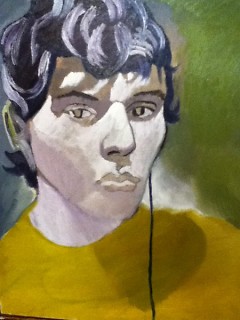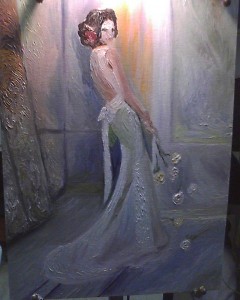Processing art becomes the subject of focus for many Grand Rapidians with the arrival of ArtPrize, yet many of us truly do not know how to judge or critique art from the viewpoint of an artist. “Art is kinda like a song,” says Tom Smith, fifth year Senior at Aquinas College, chasing his Bachelors’ Degree in Fine Art. “Even after you’ve experienced it, it still sticks in your mind. That’s how you know when a piece of art means something to you.”
Once a piece of art has caught our attention, what do we do next? As a viewer, how are we to fully understand and appreciate meaningful works of art?
Smith makes note of the fundamentals he has learned in two dimensional design and painting classes, beginning with subject matter. He poses questions as the first step in trying to understand what the artist intended to do or say:
“What is the painting about? Is the work interesting or controversial somehow? Are the ideas that the painter is trying to convey understandable?”
After taking steps to try to understand the overall theme or message in the work, Smith suggests that viewers pay attention to elements of composition, how the artist works with space, energy, form. Note “how the canvas is broken up” and then consider “the pattern of your eye across the image” as well as “the elements that draw your eye into the painting.” Smith also advises viewers to distinguish “if the painting stems from realism or thought” when trying to understand the work.
Next, Smith focuses on artistic choices behind the composition, such as materials, texture, and questions of size, shape, and scale.
He asks viewers to observe: “What materials does the artist use?" And has the artist “used materials to their potential?”
Viewers might consider “how the paint has been applied” when looking at texture and “does it mimic that of a famous artist or evoke a new style or technique?”
Size, shape and scale might also be important factors within a piece. Smith asks, “What is the scale of the painting? Does that have some impact on how you feel about it? Does the work have a monumental feel to it?”
Smith notes that he loves color and uses it quite intentionally in his own work. “I am a colorist or I’d like to consider myself one, so I generally notice the color early on...Does the color have an impact on how you feel about the painting as a viewer?”
After a viewer has visually examined a piece of art, Smith suggests that we turn to the Artist’s Statement to find out if the artist’s description reflects what we are seeing. "Differences in what you and the artist are seeing are very intriguing.” Sometimes, even the title can change the way we see the work, clarifying the message and helping to prompt that “Oh…now I see” reaction.
The sheer number of works we’re all trying to experience during ArtPrize leaves us with little time to examine art’s fundamentals in depth. Smith’s series of questions provides us with some standards to give each piece of art an equal chance to be appreciated and understood. Smith suggests that upon leaving a work, we consider what may have changed from first glance to reading the artist’s statement.
When asked to consider questions of “bad” art, such as styles or methods to avoid when making art, Smith recalls lessons about rules and directives he has learned in many classes. “I had a professor quote this to me in response to that question: ‘Once you have learned about all the rules of art, you can then break them.’ So, in all honesty, there is nothing that can be done wrong, if it is done effectively. Art students are taught the basic principles of making good art, but in some cases the art is in how you break the rules and still produce a certain quality of work.”
The beauty of art, Smith says, is examining the fundamentals and seeing into an artist’s psyche. “It is really up to each artist to determine what they are going to present to the viewer and how they are going to present it. It may mean manipulating some of the fundamentals that I mentioned to create a certain aesthetic. There are endless possibilities within the field of art, which makes art a very exciting and fulfilling discipline to be associated with.”
The Rapidian, a program of the 501(c)3 nonprofit Community Media Center, relies on the community’s support to help cover the cost of training reporters and publishing content.
We need your help.
If each of our readers and content creators who values this community platform help support its creation and maintenance, The Rapidian can continue to educate and facilitate a conversation around issues for years to come.
Please support The Rapidian and make a contribution today.


